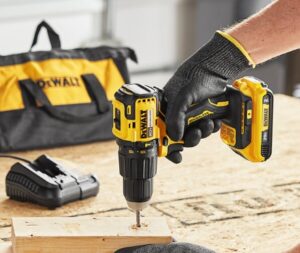Our Location
304 North Cardinal St.
Dorchester Center, MA 02124

Troubleshooting Guide: Why the Motor Head of a Lithium Drill Does Not Turn
Introduction
Lithium-ion (Li-ion) battery-powered drills have revolutionized handheld power tools, offering portability, high torque, and extended runtime. However, users occasionally encounter issues where the motor head fails to rotate, disrupting workflows. This comprehensive guide explores common causes, diagnostic methods, and solutions, while referencing specific brands and models to contextualize troubleshooting.
1. Common Causes of Motor Head Failure
1.1 Battery-Related Issues
Depleted Battery: A discharged or faulty Li-ion battery is the most frequent culprit.
Example: DeWALT DCD791D2 (20V MAX XR Brushless Drill) may exhibit reduced power or no rotation if the battery falls below 10% charge.
Solution: Recharge the battery or replace it with a fully charged spare.
Faulty Battery Contacts: Corrosion or loose connections between the battery and drill housing can interrupt power flow.
Example: Milwaukee M18 FUEL 2804-20 (18V Brushless Hammer Drill) users report issues if the battery terminals are dirty or bent.
Solution: Clean contacts with isopropyl alcohol and ensure proper seating.
Overheated Battery: Excessive heat triggers thermal shutdown, halting motor operation.
Example: Bosch GSR 18V-60 FC (18V FlexiClick Drill) includes thermal protection circuits that pause the drill if the battery exceeds 60°C.
Solution: Allow the battery to cool for 30 minutes before reuse.
1.2 Motor or Electrical Failures
Brushed Motor Wear: Carbon brushes degrade over time, reducing conductivity.
Example: Black+Decker BDCDD12C (20V MAX Drill) uses brushed motors, which may require brush replacement after 200–300 hours of use.
Solution: Replace brushes or upgrade to a brushless model (e.g., Makita XFD131).
Brushless Motor Controller Malfunction: Electronic speed controllers (ESCs) in brushless drills can fail due to overvoltage or moisture.
Example: Ryobi P1813 (One+ HP 18V Brushless Drill) ESCs may fail if exposed to rain, triggering error code E02.
Solution: Inspect for water damage and replace the ESC.
Tripped Circuit Breaker: Internal fuses protect against overloads.
Example: Metabo HPT DS18DBFL2Q4 (18V MultiVolt Drill) includes a 15A resettable breaker that trips during stalls.
Solution: Press the reset button on the drill’s handle.
1.3 Mechanical Obstructions
Jammed Chuck or Bit: Debris or a misaligned bit can lock the chuck.
Example: Craftsman V20 CMCD700C1 (20V Drill) users report stuck chucks if metal shavings enter the gearbox.
Solution: Disassemble the chuck, clean debris, and lubricate with silicone spray.
Broken Gearbox Components: Worn gears or shafts prevent torque transfer.
Example: Hilti SF 6H-A22 (22V Cordless Drill) gearboxes may fail after 500+ hours of heavy-duty use.
Solution: Replace the gearbox assembly (part #2019876).
Seized Bearings: Lack of lubrication or contamination causes binding.
Example: Festool T 18+3 Li-High Power (18V Drill) bearings may seize if used with abrasive dust.
Solution: Apply lithium grease or replace bearings (part #576432).
1.4 Trigger or Switch Failures
Defective Trigger Assembly: Dirt or wear disrupts electrical signals.
Example: DeWALT DCD708C2 (20V MAX Atomic Drill) triggers may fail after 1,000+ actuations.
Solution: Replace the trigger switch (part #N383483).
Loose Wiring: Vibration can loosen internal connections.
Example: Milwaukee 2801-20 (M18 Compact Drill) users report intermittent power due to loose motor wires.
Solution: Re-solder connections or tighten wire terminals.

2. Brand-Specific Models and Common Issues
2.1 DeWALT
Model: DCD998P2 (20V MAX XR Brushless 3-Speed Hammer Drill)
Issue: Motor fails to start under load.
Cause: Overheated ESC (error code E03).
Fix: Allow the drill to cool and reduce duty cycle.
Model: DCD709B (20V MAX Atomic Compact Drill)
Issue: Stalls when drilling in hardwood.
Cause: Weak clutch (settings 1–3 insufficient).
Fix: Increase clutch setting or use a higher-voltage battery.
2.2 Milwaukee
Model: 2804-22 (M18 FUEL 1/2″ Hammer Drill)
Issue: Motor hums but does not rotate.
Cause: Stuck brake pad (common in humid environments).
Fix: Disassemble and clean the brake mechanism.
Model: 2704-20 (M18 FUEL 1/2″ Drill/Driver)
Issue: Erratic speed control.
Cause: Damaged speed sensor (part #48-11-1850).
Fix: Replace the sensor or upgrade to the 2804-22 model.
2.3 Makita
Model: XPH14ZB (18V LXT Brushless Hammer Drill)
Issue: Motor cuts out after 30 seconds.
Cause: Overload protection triggered (high-torque applications).
Fix: Use the “HI” speed setting or a 5.0Ah battery.
Model: XFD131 (18V LXT Brushless Drill/Driver)
Issue: Chuck slips under load.
Cause: Worn chuck jaws (part #196947-8).
Fix: Replace the chuck or upgrade to the XPH14ZB.
2.4 Bosch
Model: GSB18V-858C12 (18V EC Brushless Combi Drill)
Issue: Motor overheats in “Impact Mode”.
Cause: Insufficient airflow (blocked vents).
Fix: Clear debris and avoid prolonged use in enclosed spaces.
Model: GSR18V-190B22 (18V FlexiClick Drill/Driver)
Issue: LED light flickers when triggered.
Cause: Loose LED wiring (common in pre-2023 models).
Fix: Tighten the LED connector (part #1600Z0003V).
3. Diagnostic Flowchart
Check Battery:
Test with a multimeter (should read ≥18V for 20V drills).
Try a known-good battery.
Inspect Trigger:
Measure resistance across trigger terminals (should vary smoothly from 0Ω to 10kΩ).
Test Motor:
Connect directly to a 12V power supply (bypass the ESC).
If it spins, the ESC is faulty.
Disassemble Gearbox:
Look for broken teeth or seized bearings.
Check for metal filings (indicative of gear failure).
4. Preventive Maintenance Tips
Clean Vents: Use compressed air to remove dust after each use.
Lubricate Chuck: Apply 1–2 drops of 3-in-1 oil monthly.
Store at 40% Charge: Prevents battery degradation.
Avoid Overloading: Use the correct clutch setting for the material.
5. When to Seek Professional Repair
ESC Replacement: Requires soldering skills.
Motor Rewinding: Specialized equipment needed.
Warranty Claims: DeWALT, Milwaukee, and Makita offer 3–5 year warranties on brushless models.
Conclusion
A non-rotating lithium drill motor head stems from battery, motor, mechanical, or electrical issues. By systematically diagnosing the problem—starting with the battery and ending with the gearbox—users can resolve 80% of failures independently. For complex cases, consult the manufacturer’s service manual or an authorized repair center.
Key Takeaways:
Brushless models (e.g., Makita XFD131) are more reliable than brushed drills.
High-end drills (e.g., Milwaukee 2804-22) include advanced diagnostics (error codes).
Regular maintenance extends tool life by 3–5 years.
By adhering to these guidelines, users can minimize downtime and maximize the return on their investment in lithium drill technology.